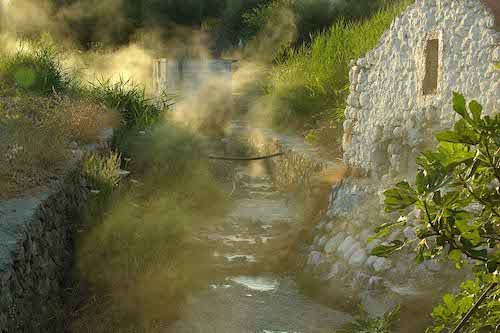(At the hot springs of Lisvori)
Weeks before strong earthquakes hit Turkey and Syria, I had sleepless nights because here too the earth shook. However not as badly as on the other side. Some houses on Lesvos were damaged, although, as far as I know, no building entirely collapsed. Underground it was pretty shaken. Since then the hot spring in Eftalou produced only a tiny jet of lukewarm water to fill the baths.
It wouldn’t be the first time that earthquakes have sabotaged the hot springs. It is a well known phenomenon, and there is a big chance that the hot water will return after a while, just like what happened on the Canadian islands Vancouver Island (Tofino) and Haida Gwaii.
Hot springs are common in volcanic areas. The red glowing magma warms ground water, that is then pushed up through holes and crevices in the earth crust. On Lesvos you have many small bubbling hot springs. Only the ones of Loutrapoli Thermis, Gera, Polichnitos, Lisvori and Eftalou are officially recognized as therapeutic centers. Greece has over the 700 hot springs, only 80 of them are considered legal. It is said that the hot springs of Leukerbad in Switzerland are the eldest in Europe, they were already known in Roman times. I bet that in ancient times, even in Thermis, you could find Romans floating in the baths. In that neighborhood plenty of ancient Greek and Roman inscriptions have been found.
The Romans, who occupied Lesvos around 80 BC and remained there for an extended holiday of some 500 years, loved water and for example saw that Mytilini was connected by an aqueduct to the now filled-in lake Megalo Limni in the centre of the island. I doubt that the Romans travelled as far as to Eftalou in the north or to Polichnitos in the south to have a hot bath. Thermis probably was in those times the most important hot spring of the island.
In 1909 the Turkish sultan Hasan Mola Moustafa had the luxury bath hotel Sarlitza Palace built next to the hot spring of Thermis. The ‘Hotel of the Yellow Springs’ then changed this little hamlet close to Mytilini into a chic bathing place attracting kings, princes and sultans. The decay of the Sarlitza started in the Sixties, maybe because it was Ottoman heritage. Nowadays it barely stands. Despite lots of actions, nobody has managed to blow new life into this beautiful old hotel. Even the springs have been closed. Since Europe produced strict laws for this kind of spa, all hot springs on the island have been closed (except for Gera that has been rebuilt and answers to the new European standards, like separate changing rooms, toilets and baths).
The hot spring of Polichnitos is now going to be rebuilt. They made a start to do that years ago in Lisvori. They covered the once green parking area with concrete and wanted to use cement for the ancient little buildings with the baths. The Archeological service was just in time to stop this barbaric renovation. But the money for the rebuilding is now gone. Resulting in a tears inducing mess.
Eftalou – the hottest spring with the highest radioactivity – has actually never been closed: it operated secretly. It is heard through the grapevine that it too will get renovated, by the people who transformed the spring in Gera into a modern health centre. For centuries Eftalou was a local spa where people went on horse or by donkey. It has a dome from the 17th century. Nearby Molyvos used to be a prosperous little town with Turkish baths (hamam), but there the water had to be heated by wood fire. The Molyvos hamam with the pretty dome was renovated some years ago, but the baths are gone. Such a shame. The building is now used for cultural festivals.
I am pretty sure that the baths in Eftalou will not disappear, especially now that meanwhile the hot water has indeed returned and the baths can be filled up again. I usually would have said that it would be a shame to renovate that special old monument. In hundreds of years, (maybe even since the Romans) nothing has been changed at the baths. But it is an old mess, begging for some action.











